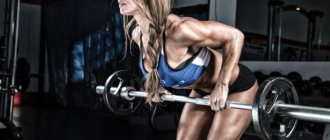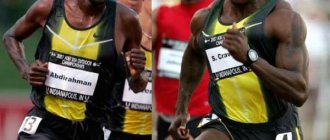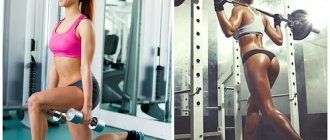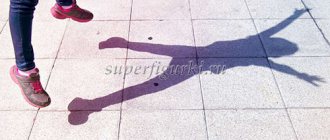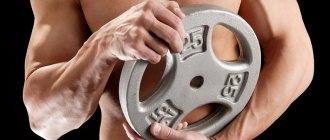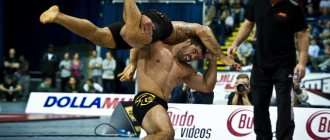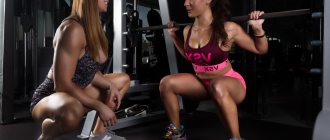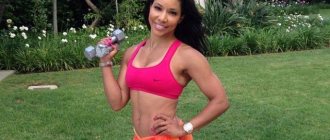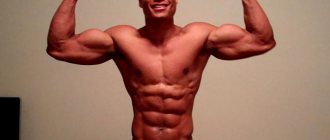Exercises on parallel bars are the best option if a person wants to pump up his triceps and chest muscles. Exercises on the horizontal bars are those that you have to perform with your body weight.
Therefore, such activities are associated with significant strength loads associated with a high risk of injury.
In order not only to protect yourself from sprains and joint damage, but also to get noticeable training results, you need to follow the training technique on horizontal bars, horizontal bars and uneven bars.
What muscles does the exercise work on?
All types of push-ups on apparatus, associated with working with your body weight, affect the following muscles:
- anterior delta;
- pectoralis major muscle;
- triceps;
- rectus abdominis muscle.
Conventionally, all types of push-ups can be classified depending on the type of muscles working when performing a fitness technique.
Important! If the main goal is to pump up the sternum, then the bars should have a wide distance between them. Maximum abduction of the shoulders from the body ensures high-quality pumping of the pectoral muscles.
To pump up the triceps, you will need equipment with a small distance between them. When, during a fitness technique, the elbows are at a minimum distance from each other, then the entire load will fall on the triceps.
The most difficult option for performing push-ups, in which the muscles of the sternum and back are maximally loaded, is push-ups on uneven bars in a lying position.
Be sure to check out:
Gallery image with caption: Swinging on parallel bars and the horizontal bar: an effective training program Gallery image with caption: Pull-up program on the bar: technical nuances and tips Gallery image with caption: Training on the horizontal bar: exercises and methods Gallery image with caption: Pull-ups on the horizontal bar for health and body beauty
Training program on the horizontal bar and parallel bars for strength
Pull-ups for strength require a fast tempo in the first phase (the pull-up itself) and a slow tempo in the second (lowering the body). The program recommends alternating basic and isolating load types. Not only do muscles increase in volume, but strength and endurance also increase.
Example training program
Day 1:
1. Start with one-handed pull-ups, grabbing the bar with a reverse grip. 2. With a reverse grip, they move on to push-ups with support on parallel bars. 3. At the end, perform pull-ups on the horizontal bar with wide arms and pull-ups on parallel bars with legs.
Day 2:
1. Start with Australian pull-ups. 2. To pump up the muscles of the chest and back, do push-ups with support on parallel bars, slightly tilting the body forward. 3. Raising your toes to your shoulders is ideal for pumping up your abdominal muscles.
Day 3:
1. Start the set with diamond push-ups resting on a low bar. 2. Switch to pull-ups on the horizontal bar behind the head with a wide stance of the hands. 3. After warming up, perform burpees with access to the horizontal bar. 4. Complete the set with pull-ups supported by parallel bars.
Execution technique
The technique of parallel bar push-ups in a training program depends on what muscles a person intends to work. Descriptions of the exercises are given in the table:
| Exercise | Instructions | Peculiarities |
| For triceps | The distance between the bars should be greater than the width of the shoulders. The starting position is a vertical position of the body and straightened arms at the elbow joints. The elbows are pulled back. As you inhale, you need to lower yourself down as far as the elasticity of your shoulder joints allows. In this case, the angle in the fold should be equal to a right angle. When performing a fitness move, the arms are pressed as close to the body as possible. As you exhale, you need to straighten your arms and rise up. | If a person has never practiced on uneven bars before, then to ease the load, the elbow joints are extended during the peak. Advanced athletes are advised to maintain a slight angle at the elbow joints to maintain a high load on the triceps. |
| On the chest muscles | The distance between the bars should be almost the same as the width of the shoulders. After jumping onto the apparatus, you need to spread your elbows to the sides. In this case, the body must be tilted at an angle of 30 degrees. As you inhale, you need to lower your torso down, while spreading your elbows to the sides. This movement should not cause muscle discomfort. Stretching should be felt in the chest area. As you exhale, contract the pectoral muscles to raise the body to the starting position. At the peak point, the shoulder blades should be brought together as closely as possible, and this position must be maintained for several seconds. | Bodybuilding and fitness experts recommend performing this fitness move after performing a bench press designed to pump up the sternum. |
| For quadriceps | Take the classic starting position, but at the same time it is necessary to bend the knee joints so that they form a right angle. The legs should be pulled up to the stomach as much as possible. In this position, it is necessary to perform pull-ups in the same way as the triceps exercise. | This fitness routine is more suitable for advanced athletes. |
What Experts Can Do
People who have extensive experience on the uneven bars usually choose exercises that are more difficult and interesting. It is necessary to move on to these exercises slowly.
When performing a complex for experienced ones, it is necessary to gradually add exercises for experts to them. The number of repetitions should increase. Combinations must become increasingly sophisticated.
Exercise “Triangle”
- We stand on straight arms. Position A.
- We bend our arms at the elbow joints and lower ourselves down. This is position B.
- We move slightly back, placing our forearms on the bars.
- Return to position B.
- We do push-ups. Return to starting position.
- Repeat the exercise.
Exercise “Horizontal emphasis and triangle”
- You are in a horizontal position on the bars. Hands and feet on uneven bars.
- The body needs to be extended in line with the legs.
- We bend our arms at the elbow joint and lower ourselves down.
- Move your torso slightly back.
- Place your forearms on the bars.
- Reverse movement and return to previous position.
- Repeat the exercise.
Korean push-ups
- Straight arms stand on the bars.
- Your back is turned to the bars.
- In the initial position, the arms are slightly bent at the elbow.
- We bend our arms and lower ourselves lower, our feet should not fall to the floor.
- We return to the starting position and repeat the exercise.
Swings and transitions
- Straight arms on the uneven bars.
- Your legs need to swing slightly forward.
- Then throw your legs over the bars and spread them apart.
- You need to lean on your legs and move your body to the front.
- Cross your legs over the bars.
- Bring your legs together and back.
- Considering that there is already enough inertia during execution, it is necessary to immediately repeat the exercise.
Exit by force on the crossbars
- Stand to the side of the bars.
- Place your hands on the bars from above and weigh on them. Legs raised above the floor.
- You need to pull yourself up. We throw our shoulders over the bars.
- Next - push-ups with straight arms.
- We move in reverse order.
- Return to original position. Repeat.
Note! Try to rise up consistently and in one movement.
Rotate 360 degrees
- Your arms are straight and you are standing on the bar.
- It is necessary to make a turn to the right side and quickly move your left hand to the opposite crossbar.
- We continue to rotate to the right. We move our right hand to one of the bars, which is located behind you.
- Place two hands on the bar.
- We continue to rotate and return to the starting position.
- Now repeat in the opposite direction.
- Repeat the exercise.
Common mistakes and recommendations for beginners
Exercises on the uneven bars and horizontal bar are associated with a high risk of injury, since the load on the joints of the shoulders and pectoral muscles is provided by the own body weight of the person who is training.
The most common mistakes made when doing dips include:
- Incorrect grip width: this distance should always be the same as the distance between the shoulders. If the grip exceeds shoulder width, then the risk of ligament damage increases.
- Improper breathing: disruption of the rhythm of inhalation and exhalation makes training ineffective. You should always inhale before going down. If at this stage a person inhales, the chest, expanded as a result of filling the lungs with air, will become more susceptible to injury. But at the point of descent you need to take a deep breath.
- Violation of training speed: too fast movements, reminiscent of jerks, make training ineffective. You need to pull yourself up slowly, trying to stay at each stage of the exercise for at least 1-2 seconds, trying to feel the maximum tension in the muscles that are involved in the load.
- Ignoring the warm-up: working with your own body weight always requires intense contractions of the muscles of the back and shoulder girdle. Therefore, before the main workout, a warm-up warm-up is required. These are easy exercises that involve the arms and shoulder girdle.
Often, beginners who want to get pumped up triceps and pectoral muscles as soon as possible intend to perform push-ups on uneven bars in their first workout, complicating the exercises by tying them with weights. This is a grave mistake, since for an untrained body, difficult training can lead to injuries to the ligaments and joints of the upper extremities.
To start working productively in the first lesson on the uneven bars, beginners need to take into account the following recommendations:
- You should not immediately train on full uneven bars. The gravitron, a simulator equipped with a pillow to support the knees, will help you prepare for working with your own body weight. This approach will make it easier to perform a fitness routine.
- At the first stages of training, it is recommended to do push-ups with an incomplete amplitude, without lowering the body to the lowest point.
- You can enlist the support of an assistant or instructor who will support the legs of the training beginner during the process of push-ups.
Before you begin full-fledged training on the uneven bars, you need to train the muscles of the sternum and shoulders with the following exercises for at least several weeks:
- classic bar;
- military push-ups;
- Dumbbell bench press in a lying position.
Trained muscles will allow you to do push-ups with minimal risk of injury.
Types of push-ups
Downloading the press
It’s quite possible to pump up your abs using parallel bars if you know how to do pull-ups correctly. Moreover, you can make both the upper and lower abdominal muscles work.
Before you start exercising, try working your abs at home with push-ups. In this way you will prepare your hands and strengthen your joints. Having passed this stage, you can move on to the projectile.
Below are the most effective exercises that will help pump up your abs using parallel bars.
Imitation of walking on uneven bars.
Stages:
- beginning of the exercise – parallel bars with straight arms;
- then we tilt the body forward and tilt the head;
- Next, we raise one knee above the level of the bars;
- when lowering one knee, we perform the same actions with the other;
- the result is an imitation of a step with the knee raised in the air;
- repeat about ten times.
The exercise is well suited for beginners and those who still have weak hands.
Leg Raising
This is a standard exercise. There are several options for execution: from a position with outstretched arms and with your elbows resting on the bars. The position with your elbows on the bars is dangerous: there is a high risk of your hands slipping, so be careful.
Execution steps:
- we start from the starting position;
- tilt the body forward;
- we raise our legs (if you raise them to the level of the apparatus, then the lower part of the abs is pumped, and if to the level of the chest, then the upper part is pumped);
- repeat about ten times in three approaches.
There are some nuances to performing this exercise: you need to lift your legs in a bent state, otherwise the body will sway.
If you have mastered this technique, then it makes sense to put weights on your legs for greater pumping. This way you can pump up your abs even more.
roman chair
Using this exercise will give you the opportunity to use the muscles of your back and upper abs.
Execution steps:
- sit on one pipe, and under the other we throw our legs and cling;
- we throw our hands behind our heads and fasten them into a lock;
- We bend backwards so that the body is parallel to the floor;
- repeat the exercise 15 times in two or three approaches.
Triceps push-ups
Start your workout by working on your triceps, and then move on to wide-grip push-ups to pump up your chest.
Let's consider a standard version of performing push-ups on the uneven bars to work on the triceps.
Execution steps:
- take the starting position, jump onto the bars and turn your palms towards the body, your arms should be extended;
- take a deep breath through your nose and gradually lower yourself down until the angle of your elbow joint is 90 degrees;
- gradually exhaling, begin to rise;
- do 10 push-ups in three to four sets.
Advice! Go down slowly and go up quickly. Press your hands tightly to your body.
Another way to work on the triceps is horizontal push-ups. If you easily manage to repeat all these actions and you feel strong after completion, then next time you can lift weights. But take your time and don't overdo it. During training , place triceps push-ups at the beginning.
Developing chest muscles
After working on your triceps, you can begin chest dips. In order for the chest areas to receive more load, you need to change your technique and body position. To work your chest, lean your body forward and point your elbows out to the sides. This will work well for the lower chest muscles.
The distance between the bars should be several centimeters greater than the width of the shoulders.
Let's move on to execution and look at how to pump up the pectoral muscles on the uneven bars:
- take the starting position on the uneven bars and do not forget about the correct position of your elbows, as well as tilting your body forward;
- do not forget to breathe correctly - inhaling through your nose, gradually lower yourself down, spreading your elbows to the sides;
- lower yourself until the angle of the elbow joint is 90°;
- exhaling through your mouth, return to the starting position and pause for a few seconds;
- repeat ten times in three approaches.
As in the previous version, focusing on the chest and having mastered these exercises, you can begin to perform them with weights.
We use weights
To increase muscle mass, weighted dips are practiced.
Weighting should be started only after preliminary preparation. First you need to master the classic technique of performing chest exercises. Once you master it and feel strong, you can gradually take on additional weight. The extra weight is an excellent alternative to barbell training.
Weighted dips are usually performed using a special corset or belt to which weight plates are added.
Heavy weight plates are added when the exercise is done with minimal additional weight.
Dips as part of a training program
In order for the classes to be beneficial, there are special training programs that describe how to exercise correctly.
The purpose of such programs:
- increasing the athlete's endurance;
- strengthening hands;
- development of the shoulder girdle;
- increasing the number of approaches and repetitions;
- formation of a relief body.
Before starting classes, you should consult your doctor.
Programs, as a rule, are built on a scheme of several levels, for athletes with different physical fitness.
Do not forget that any workout should begin with a warm-up, the emphasis is on warming up the shoulder girdle.
Program No. 1
The goal of the program is to complete 50 repetitions at one time. The training system is divided into three levels. Before starting the first level, the athlete must be able to do at least seven push-ups. After passing the first difficulty level, rest for two days.
During the training period at the other two levels, there are one-day breaks.
First level. The goal is to complete 10 dips in one set.
- Stage one. Do 50 push-ups in as many sets as you feel comfortable with. You can even do ten approaches. It is advisable that the breaks between them be about two minutes. Gradually reduce the number of approaches. Then rest for 2 days.
- Stage two. Do 50 push-ups in three sets. Rest between sets is four or five minutes, no more.
Second level. The goal is 20 push-ups in one set.
- Stage one. Do ten repetitions of five sets. Rest during breaks - no more than two minutes. If your strength allows you to do more, then you can increase the number of repetitions. As a result, it is advisable to do twenty repetitions in one attempt. After the first day - one day of rest.
- Stage two. Experienced athletes know a technique called a superset. This is the continuous performance of several types of exercises in a row. We apply this technique and do push-ups as many times as possible, then immediately move on to push-ups from the floor without a break. We perform four supersets with breaks of ten minutes.
Third level. The goal is 25 push-ups at a time.
- First stage. We do push-ups as many times as possible. Three approaches. We rest no more than 30 seconds between attempts. Upon completion, rest for five minutes. And we repeat everything again so many times until you have no strength left. The next day we rest.
- Second phase. By this stage, you should have increased strength to perform at least 20 push-ups in one approach. We do five sets of 20 repetitions. Rest for five minutes between sets.
Program No. 2
| Dips circuit (17 week program) | |||||||||||||||||
| A week | 1 | 2 | 3 | 4 | 5 | 6 | 7 | 8 | 9 | 10 | 11 | 12 | 13 | 14 | 15 | 16 | 17 |
| First approach | 10 | 15 | 20 | 25 | 30 | 35 | 40 | 40 | 45 | 45 | 50 | 50 | 55 | 60 | 60 | 65 | 65 |
| Second approach | 5 | 15 | 20 | 25 | 30 | 30 | 35 | 40 | 40 | 45 | 45 | 50 | 50 | 55 | 60 | 60 | 65 |
| Third approach | 5 | 10 | 15 | 2 | 25 | 25 | 25 | 30 | 35 | 35 | 35 | 40 | 40 | 40 | 45 | 45 | 45 |
| Fourth approach | 3 | 5 | 15 | 15 | 20 | 20 | 25 | 30 | 35 | 35 | 35 | 40 | 40 | 40 | 45 | 45 | 45 |
| Fifth approach | 2 | 5 | 10 | 10 | 15 | 15 | 15 | 20 | 25 | 25 | 30 | 35 | 35 | 35 | 40 | 40 | 40 |
| Total | 25 | 50 | 80 | 95 | 120 | 125 | 145 | 155 | 180 | 185 | 195 | 215 | 220 | 230 | 250 | 255 | 260 |
Training program to increase the number of movements from scratch
In order to gradually increase the number of push-ups, a person who has never trained on apparatus needs to start training smoothly.
The program for beginners looks like this:
- For a month, twice a week you need to devote 30 minutes to push-ups.
- After preparing your muscles with push-ups, you need to set a goal of doing 50 dips on the uneven bars in one workout. The number of approaches can be any. However, with each training session their number needs to be reduced. You should try to do 7 push-ups in 2 sets and 6 push-ups in 6 sets. Between approaches you need to rest at intervals of 1 minute.
Beginners are not recommended to use weights.
Training program on the horizontal bar and parallel bars for weight
Mass exercises on the horizontal bar and parallel bars are performed either for each muscle segment on a separate day, or combined for 1-2 segments. An addition to every training regimen is abdominal pumping.
Gaining mass on the horizontal bar requires performing exercises in 4-6 sets of 6-8 repetitions. Rest between sets should not exceed 3 minutes. The program is designed for an average level of fitness. To increase the intensity of the load, use a vest or weight belt.
Vests, cuffs and limb belts are used as weights and weights when working on the horizontal bar and uneven bars. Such weights are secured with Velcro and do not restrict the movement of the hands. To reduce slipping, it is recommended to wear gloves.
Example training program
Day 1:
1. To pump up your back on the horizontal bar, do pull-ups with your arms wide. 2. Then they move on to Australian pull-ups. 3. To train the core muscles, preference is given to raising the knees with emphasis on the uneven bars. 4. The set ends with deep dips.
Day 2:
1. On the horizontal bar, perform biceps pull-ups and reverse-grip pull-ups with a narrow position of the arms. 2. After rest, move on to a pullover with a reverse grip with partial amplitude. 3. Finish the arm workout with biceps pull-ups on a low bar.
Day 3:
1. Start with diamond push-ups with emphasis on a low bar. 2. After rest, move on to triceps extensions. 3. On parallel bars, perform push-ups from a horizontal support. 4. Finish the training by raising the knees to the shoulders, resting on the bars.
The benefits of working with weights
Hanging weights such as metal chains, barbell plates and kettlebells from your legs can increase the load on the muscles of the sternum and arms. Weighting of body weight due to sports equipment increases the effectiveness of exercise while increasing the risk of injury.
To avoid damage to joints and ligaments, you need to start exercising with minimal weights. A beginner should try to train with a projectile whose weight does not exceed 5 kg. Gradually, this indicator needs to be increased, focusing on your own feelings.
What muscles are used by dips?
Dips use a very large number of important pressing muscles. Such as:
- Triceps. 3 heads work at once. Long, medial and lateral. At the same time, you need to understand that when performing any of the push-up options, the triceps will receive a load. It’s just that with an emphasis on it it will be much greater.
- Delta. Not all deltoid bundles take an active part, but only the anterior one.
- Pectoral muscles. We are talking about the lower sections, the so-called abdominal (abdominal) region of the chest. It is push-ups on the uneven bars that allow you to work out these departments in detail.
- Coracobrachialis muscle. This is a small muscle that is also involved in this exercise. It is located under the anterior delta. If the technique is incorrect, it can be easily injured.
- Serratus anterior muscle.
Responsible for the movement of the shoulder blades, namely their spreading to the side. Therefore, he actively takes part in the moment of the press itself.
As you can see, the exercise really has the right to be called basic, since it involves a large number of muscles. And of course several joints: shoulder and elbow. For people who want to achieve larger muscle masses, this is good news.
Main conclusions
- Dips are useful for strengthening the muscles of the upper limbs and chest. But these fitness techniques come with a high risk of injury, so you need to train correctly.
- To train your triceps, you need to train on parallel bars, the distance between which is slightly wider than the distance between your shoulders. If it is necessary to work the sternum, then the distance between the bars should be the same as between the shoulders.
- If a person does not have experience in performing push-ups with his own weight, then it is recommended that he begin with regular push-ups.
- Advanced athletes can make push-ups more difficult with various weights that increase the load when working with body weight.
Emphasis on the chest
Dips are great for both beginners and advanced athletes. Professional athletes can use additional weights, such as a weighted vest.
In order to focus the load specifically on the chest muscles, you need to understand exactly what functions they perform in our musculoskeletal system.
- The main purpose of the pectoral muscles is to bring the arms towards the body, bring them closer to each other and rotate them inward. Accordingly, in order to make these muscles work, you need to spread your arms (in our case, the elbows) wide, move them away from the body and make sure that the force of resistance interferes with bringing them back. This force is the weight of your own body.
- We also know that when performing chest exercises, depending on the angle observed between the torso and arms (arms perpendicular to the body, lowered down or raised up in front of the body), the corresponding part of the pectoral muscles receives the load. Since when performing push-ups on parallel bars, the arms are brought forward and lowered in relation to the body, the lower part of the chest receives the maximum load. By leaning our body forward, we also turn on the middle part. If we hold our torso completely upright or even lean back, the triceps take over the initiative, and the pectoral muscles work less.
The technique of performing the movement follows from the above. The chest style of push-ups will be described in detail below; now it is important for us to understand how the muscles work.
It is also worth noting that it will not be possible to completely exclude the triceps from the movement, since these muscles work in synergy with the pectoral muscles. Additionally, the shoulder muscles (deltoids) are also involved.
The exercise we are talking about is sometimes called wide-grip push-ups, by analogy with classic push-ups. However, the distance between the bars for doing push-ups should be slightly wider than shoulder width. This is due to the fact that if the width of the bars is too large, there is a high risk of injuring the shoulder joints, and if the distance is too small, it will not allow you to perform the movement. Therefore, the concepts of “wide grip” and “narrow grip” are very relative here.
Working out the press on uneven bars
In pursuit of the desired six-pack, people become fixated on classic crunches and well-promoted benches. Meanwhile, it is the parallel bars that can provide the fastest and most aesthetic pumping of the lumbar region, but the role of this projectile has been undeservedly forgotten.
In addition to the fact that the abdominal and oblique muscles work as auxiliary muscles in any exercise on the uneven bars, there are ways to focus specifically on the abs. Here is one of them:
We perform an approach to the uneven bars in the starting position, with weights on our feet.
Raise your knees towards your body, keeping it straight. The first repetition is lifting straight, the second is bending to the left, the third is to the right.
And such a cycle is for about 15-30 repetitions, the number of approaches until failure. Recovery break for three days.
After several months of training, when lifting with bent knees becomes too easy, repeat the same thing with straight legs.
Why is this more effective than traditional methods?
The abdominal and oblique muscles work synchronously with the support of the back in everyday life, and the load on them is distributed evenly.
As with practicing this method. Collaborative work will give a more tangible effect than local work.
Dips with emphasis on triceps
As mentioned at the very beginning of the article, this option is more basic. It is used by a large number of athletes around the world. Push-ups with an emphasis on the triceps are especially good for beginner athletes. They will be able to feel the work of this muscle and strengthen their ligaments. This will be an excellent preparatory basis for further work with heavy weights. In order to shift the focus to the triceps, two factors must be taken into account.
Firstly, body position. The more we lean forward, the more the load shifts to the pectoral muscles. Therefore, we must keep our body as straight as possible. A slight tilt is done in order to reduce the load on the claviobrachialis muscle.
Secondly, grip width. In order to work the triceps well, we need to isolate them from the pecs. Narrow or medium-width beams will help us with this. By performing push-ups on them, it will be easier for us to move our elbows back. This will stretch all 3 heads of the triceps more. And breasts will be practically excluded from the movement. But still, they will also receive the same load.
Initial position:
For this type of dips on the uneven bars, ordinary standard parallel bars are best suited for us. The narrower the distance between them, the better.
- We grab the bars with our hands, with a neutral grip (palms facing each other).
- Next, we need to put emphasis on them. In order to do this, we can push off the ground a little with our feet. And at the same time straighten your arms. If it's so hard for you to do. Then take some kind of stool and climb onto the bars from it.
- While standing, release your shoulders down and stretch your trapezius as much as possible.
- The body is slightly tilted forward. So that we feel comfortable. The main thing is not to overdo it, and not to shift all the emphasis from triceps to pectorals.
- The legs are bent at the knee joint.
Performance:
- We take a deep breath and bend our arms at the elbow joints.
- Hold this position for a short time to maximize the stretch in your triceps.
- As we exhale, we straighten our arms with effort and return the body to its original position.
Our main task is to control the movement itself. After completing the approach, we carefully lower ourselves to the floor. Don't jump off the bars. You won’t surprise anyone with this, but you can easily lose your balance or twist your leg.
Recommendations for implementation
- Don't lower your body too much. A 90° bend in the elbow joint is sufficient. If you feel like you can go a little lower, then go ahead. But if at the lowest point you feel pain in the shoulder joint. Then you have clearly overdone it, and you should reduce the amplitude a little. In short, experiment and find the optimal range of motion.
- When doing dips, your elbows should go back, not to the side. This is done in order to exclude breastfeeding from the work.
- Do not fully extend your arm muscles at the top. This will remove all the stress from the triceps and shift it to the elbow joints. This will not affect the growth of the triceps in any way, but the risk of injury will be very high.
- Bending and extending your arms should occur under your control. Avoid inertial movements. Our main task is to feel the work of the triceps, and not to finish the exercise as quickly as possible.
- Do not bend your legs at the hip joint. This will cause your torso to lean forward and shift the emphasis from the triceps to the pecs.
- The gaze should be directed forward. This way we will avoid rounding in the back.
- Avoid swaying while moving.
- Make sure that your shoulders are pulled straight back and not to the sides.
If you adhere to all these rules, and also bring the execution technique to perfection. Then your progress will not be long in coming. And what “trauma” is will not be familiar to you.
